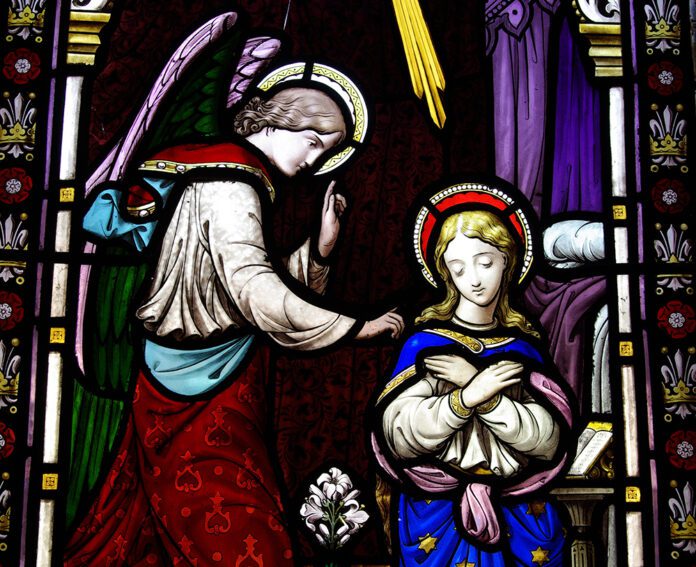From September 8th to September 15th, the Catholic Church traditionally celebrates the octave of the Blessed Virgin Mary. This devotion begins on the Feast of her Birthday until her Feast as Our Lady of Sorrows. This octave serves as a beautiful remembrance of Our Blessed Mother, who reigns in Heaven, and commemorates her earthly life.
Oftentimes, we forget that our heavenly friends endured the anxieties and joys that life brings. We tend to focus on their good deeds, prayer lives, and deaths, wondering and hoping that perhaps one day we might be able to gain a small percentage of their faith and courage. This mindset causes us to forget that they, too, were human.
Our Lady, Queen of All Saints, is no exception.
Her life was one of both joys and sorrows. The Church holds this belief so dearly that there is a devotion to these areas of her life. Not only did Our Lady give the Rosary to St. Dominic to ensure that we meditate on her and Christ’s lives, but we are also given her seven sorrows and joys.
The Seven Joys
Since Our Lady’s octave begins with her birthday, it is fitting to first examine her Seven Joys as listed by Fr. Romanus Cessario, O.P.
- The Annunciation
- The Nativity of Jesus
- The Epiphany
- The Resurrection of Jesus Christ
- The Ascension of Jesus Christ into Heaven
- Pentecost – The Descent of the Holy Spirit
- The Assumption and Coronation of the Virgin Mary
In contemplating the Annunciation, we recall how Our Lady valiantly accepted God’s calling for her life. She could have said no to being the mother of God, but she readily accepted despite the personal danger it posed for her. In Jewish tradition, she could have been stoned for being pregnant before she and St. Joseph lived together. However, we see her beautiful witness of trust as she accepted that all would be well in God’s timing – “Behold the handmaid of the Lord; be it done to me according to thy word” (Lk. 1:38).
The Nativity of Jesus once again demonstrates Mary’s trust in God. St. Joseph looked for an inn to suit the needs of mother and child. Instead, Mary joyously birthed the Savior in a humble stable or some scholars denote the place to be a cave. Mary’s witness is still one of joy as she is able to hold not only the infant that she carried in her womb for nine months, but the prophesied one that the Jews had been longing for, for generations!
The third joy is the Epiphany also known as the Adoration of the Magi. There are many legends and stories surrounding Caspar, Melchior, and Balthasar; however, we can only imagine what joy it brought Our Lady to see these wise men come to worship the Christ Child. How reassuring it must have been for both her and St. Joseph, and what a reward for their trust in God thus far!
After losing her Son, it is understandable that Our Lady would receive such joy in Christ’s Resurrection. Truly, this was a twofold joy as mother saw her Son alive again, while simultaneously perceiving how Christ in His dual nature conquered sin and death for the entire world.
Our Lady’s fifth joy demonstrates her higher knowledge. She finds joy as Christ ascends into Heaven. This is a time where many would feel abandoned. Our Lady did not. She comprehended that her Son’s mission was complete, which was a joy! Also, she knew what joy would come next.
Pentecost, also called, the Descent of the Holy Spirit, is what we consider to be the Birthday of the Church. Our Lady received the Holy Spirit with the Apostles in the upper room. In Scripture, we can recall the answer to Mary’s question, “The Holy Spirit will come on you, and the power of the Most High will overshadow you. . .” (Lk. 1:35). In this way, Our Lady witnesses by her comforting presence to the Apostles and in the birth of the Church that she will be the Mother of the Church, just as she accepted becoming the Mother of God at the Annunciation.
Finally, the seventh joy is the Assumption and Coronation of Our Lady. Our Lady is crowned Queen of Heaven and Earth after she is assumed body and soul into Heaven. She has run her race and continues to in Heaven for the good of the Church and her children. She reigns from Heaven with her Son, our Savior, Jesus Christ.
The Seven Sorrows
The octave ends on September 15th — the Feast of Our Lady of Sorrows. In recalling Our Lady’s sorrows, we can acknowledge how much she suffered out of love for Christ and the Mystical Body of Christ — the Church, which we compose.
- The Prophesy of Simeon
- The Flight into Egypt
- The Loss of the Child Jesus for Three Days
- The Via Dolorosa – Christ Meets His Mother
- The Crucifixion
- Jesus is Taken Down from the Cross
- The Body of Christ is Entombed
The Prophecy of Simeon is where we first hear “thy own soul a sword shall pierce. . .” (Lk. 2:35). This begins Mary’s sorrowful journey after the first three joys she experiences as the mother of God.
The Flight into Egypt doubly pierced Mary’s heart. Not only did Herod intend to kill her Son, but he slaughtered what the Church has deemed The Holy Innocents. Surely, Mary felt not only her pain, but the pain of the Jewish women who lost their babies.
When Christ was older, he was lost for three days. We often contemplate this in the Joyful Mysteries of the Rosary as The Finding of Jesus in the Temple, but first, Christ had to be lost. What anguish must Our Lady have felt when she and St. Joseph discovered that Christ was not with either of the traveling caravans. “Son, why hast thou done so to us?” (Lk. 2:48). Our Lady’s words speak volumes of how much pain she must have felt in losing not only her Son, but the Son of God.
The fourth sorrow is when Christ and his Mother Mary meet on the road to Calvary. This is also depicted as the fourth Station of the Cross. The Latin 13th century hymn and prayer, Stabat Mater Dolorosa, sums this sorrow perfectly in verse five: “Is there one who would not weep, / Whelmed in miseries so deep, / Christ’s dear Mother to behold?” The entire hymn was traditionally used to honor Our Lady of Sorrows every September 15th as the Liturgical Sequence.
Next, the fifth sorrow is the Crucifixion. “For the sins of His own nation, / Saw Him hang in desolation, / Till His spirit forth He sent.” (Stabat Mater Dolorosa, verse 8). What agony Our Lady must have felt witnessing her Son take his last breaths. What magnitude this pain must have had as she knew He was not just her Son, but the Son of God, completely innocent of all sin.
The sixth sorrow is visually encompassed in Michaelangelo’s famous Madonna della Pietà. Christ is taken down from the cross and laid in His Mother’s arms. She weeps as a Mother for her Son. She weeps as the Spouse of the Holy Spirit. She weeps as God the Father’s Daughter. What anguish and emptiness her soul must have felt as she held Christ’s lifeless body. Compared to Christ, Michaelangelo depicts Our Lady as larger than His body denoting both her tremendous grief and motherly strength.
Lastly, the seventh sorrow is Christ’s Entombment. No longer able to care for her Son’s body, Mary is completely separated from Him. Many theologians believe that Christ appeared to His mother first before St. Mary Magdalene to comfort her, which is why she did not rush to the tomb.
In recalling and contemplating the Seven Joys and the Seven Sorrows of Our Lady, we are reminded not only of her love for Christ, the Church, and for each one of us, but also of her humanity.
Although we often think of the Blessed Mother as perfect and beautiful in every way, we should remember that such radiant perfection and beauty does not mean omission of her humanity. She is a woman of both joys and sorrows. This is why when we suffer, we should ask for her consolation under her title of Our Lady of Sorrows. When we experience joy, we should express our thanksgiving to her Son, Jesus Christ, asking her especially to deliver our gratitude to Him as Our Lady, Cause of Our Joy.






